Tar Sands Oil Production, An Industrial Bonanza, Poses Major Water Use Challenges
Tapping North America’s tar sands and oil shales, say proponents, will help ensure that Americans continue to enjoy a lifestyle built on choice and mobility. But the cost to water quality and supply, and climate change, is already enormous.
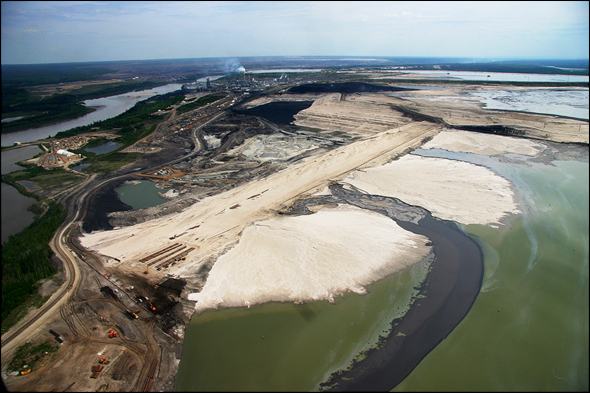
By Keith Schneider and Sam Kean
Circle of Blue
From the air, the oil-bearing tar sands mines of northern Alberta, Canada, the largest industrial project on Earth, look flat. But that’s only because they lie in scattered cuts across a forested landscape that is more than 100 miles wide.
On the ground in Union County, South Dakota, more than 1,700 miles south of Alberta, the place where 400,000 barrels of that tar sand oil could be refined daily into gasoline, diesel and jet fuel is still a six-square-mile expanse of prairie and farm fields awaiting a $10 billion refinery, the first new refinery in the U.S. since the 1970s.
Tying these two immense industrial installations together are lengthy steel pipelines, one nearing completion by Trans Canada, and another promoted by Canada’s prime minister and the American president. Both the tar sands and the proposed South Dakota refinery represent the vanguard of the economically promising and exceedingly ecologically risky opening of the next era of global petroleum development.
Unconventional Production
Instead of drilling wells deep underground energy developers are starting to dig up the vast reserves contained in oil-saturated sand and shale that are much closer to the surface. Propelling the development of so-called “unconventional fuels,” say Department of Energy authorities, is America’s rapacious appetite for oil— now almost 20 million barrels daily, 7 billion barrels annually. It’s also the increasing scarcity, risk, and expense of securing the last big conventional oil reserves, a trio of issues illustrated most graphically by the deep-sea BP Gulf explosion and blowout, which killed 11 men in April and poured nearly five million barrels of oil into coastal waters until the well was sealed in August.
Energy industry executives and federal energy specialists insist that tapping the tar sands and shale oil reserves ensures that Americans will continue to enjoy a lifestyle built on choice and mobility for decades more. Colorado, Utah and Wyoming hold oil shale reserves estimated to contain 1.2 trillion to 1.8 trillion barrels of oil, according to the Energy Department, half of which is recoverable. Eastern Utah alone holds tar sands oil reserves estimated at 12 billion to 19 billion barrels. The Alberta tar sands region contains recoverable oil reserves conservatively estimated at 175 billion barrels.
“We can increase our output,” said Tim Markle, a spokesman for Alberta Energy, the provincial agency that oversees tar sands development. “We’ve only tapped the near surface of the oil sands. We estimate there could be somewhere in the neighborhood of 1.7 trillion barrels of oil. Right now we don’t know how to get to it.”
Huge Investment, Big Water Choke Point
But as government agencies and energy companies pour billions into production and research, a handful of technical specialists and scientists are taking a hard look at the environmental risks, including the availability of fresh water: a choke point that seems all but certain to limit unconventional fuels development.
Existing oil production in the United States from conventional reserves withdraws one billion to two billion gallons a day from rivers, lakes, and aquifers, according to the United States Geological Survey. Turning conventional oil into fuels and other products consumes about the same amount, most of it to cool the nation’s 143 refineries.
Mining and processing tar sands and shale oil, though, requires much higher quantities of water. It takes four to six barrels (124 to 186 gallons) of water to produce one barrel of tar sands oil, which is four times more water than it takes to produce oil from conventional reserves, according to a 2009 study by Argonne National Laboratory. Meanwhile producing one barrel of shale oil takes two to three times as much as conventional oil.
Much of the water to produce oil from tar sands comes from the Athabasca River, which runs through the northern Alberta mining district. The Alberta provincial government granted tar sands oil producers the license to withdraw 652 million cubic meters of river water annually—equal to 172 billion gallons—for mining and processing.
In 2008, according to Energy Alberta, tar sands mines actually used 184.3 million cubic meters of water — 48.7 billion gallons. That’s roughly the same amount of water that the entire American oil industry consumes in a month.
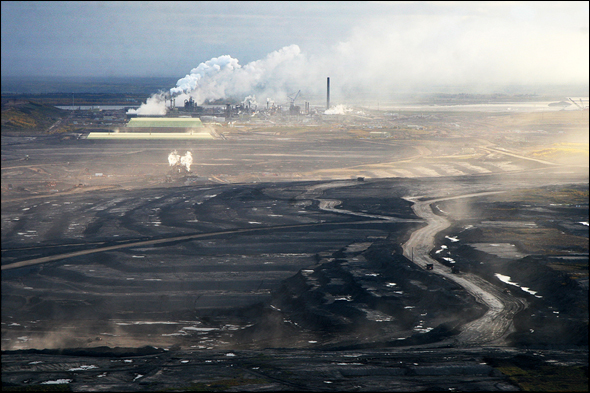
Polluted Water, Limits on Water
Just 10 percent is returned to the river, which a number of independent studies say is visibly depleted and rapidly deteriorating. The balance is poured into toxic tailing ponds as big as lakes, containing more than 1 trillion gallons of waste water combined and so polluted that at least 1,600 ducks that inadvertently landed in them have died, drowned by the tarry water.
The Canadian government, in concert with big oil companies from the United States, Canada, China, Korea, and Europe say the tar sands region is capable of producing four million barrels of oil a day, or more. Much of it is meant for the United States.
But in an interview with Circle of Blue, Mike Hightower, an engineer at Sandia National Laboratories and one of the top American experts on the competition between energy and water, said such levels of production may be impossible to achieve.
“Canada has a lot of fresh water,” said Hightower. “But we are beginning to see limits on development of the oil sands. You will see limits where production hits a plateau and won’t get above it. The point is that a couple of years ago they were talking about three million or four million barrels a day. The water resources won’t allow them to go there. They will cap out at 2.5 million.”
Similarly, water scarcity will limit oil shale development. Much of the oil shale in the United States occurs in the deserts of the Rocky Mountain West, where climate change, according to an analysis by the EPA earlier this year, is reducing snowmelt and rainfall resulting in less moisture in rivers and aquifers. Philip Smith, a professor of chemical engineering and director of the Institute for Clean and Secure Energy at the University of Utah, said his state’s shale oil can’t be tapped using water-intensive technologies.
“In Utah, we just do not have that kind of water,” Smith told researchers at the National Institute of Environmental Health Sciences.
Refineries on Dry Land
Moreover, building new American refineries that are closest to the shales and tar sands also means siting them on the water-scarce Great Plains, putting new pressure on surface and underground water supplies. The proposed Hyperion refinery in southeast South Dakota, which sits just across the Missouri River from Iowa, would use 12 million gallons of water a day for oil processing and cooling. The source of the water is an aquifer that the U.S.G.S. said is stressed from over pumping by farms. The plant’s wastewater will (after processing) be poured into the Missouri River.
Both phases of the plant’s water use have come under new scrutiny. Water managers in South Dakota have already told investigators with the General Accounting Office, a unit of Congress, that they anticipated shortages of water over the next decade. And last month Richard Leopold, director of the Iowa Department of Natural Resources, sent a letter to the South Dakota Department of Environment and Natural Resources, as well as the U.S. Environmental Protection Agency that called for a more thorough assessment of the plant’s risks to the environment, including from its water discharges.
Leopold said the plant’s wastewater could affect power plants, drinking water supplies, recreation, and farm operations in Iowa.
“It is always prudent to complete due diligence on a major project of this scale and significance,” Leopold wrote.
South Dakota has not responded to the request. Last year, though, the state environmental office ruled the refinery did not need to submit a full environmental impact statement.
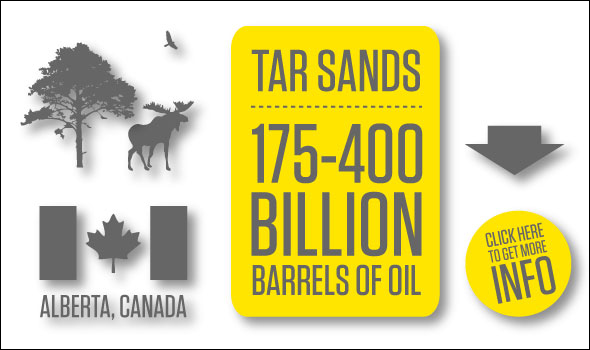
Resistance and Delays Hamper Refinery
Water also is a source of deep local resistance to the Hyperion refinery plant. On January 28, 2010 the Clay Rural Water System board of directors unanimously denied Hyperion’s request for a long-term agreement to use up to 12 million gallons of water per day at the proposed refinery. Three months later, Hyperion executives announced that civic resistance, permit delays and the weakened economy was impeding the project timeline. The company postponed closing on land purchases for the project. Instead Hyperion has asked landowners to extend land lease options that are set to expire this month.
Attitudes about the proposed refinery are decidedly divided.
“My grandpa, he would have jumped at this,” said Don Abraham, a farmer and physics professor at the University of South Dakota. “Imagine leaving Norway, looking for a better life, looking for wealth, looking for opportunity—then something like this comes along? I really think he would have jumped at an opportunity for the area to develop.”
But when Union County voters approved a rezoning measure two years ago that made it possible for Hyperion to build the refinery on farmland, a sizable opposition movement also made its presence felt. Terse political signs began straddling barbed-wire fences, painted the reds, yellows, and blacks of venomous snakes: “Vote No Hyperion.” And beyond any environmental doomsday, opponents asserted that refinery workers, hordes of young men, would attract strip clubs and sow vice—moral Armageddon.
Soon, local churches were rent down the middle; pastors had to watch their tongues. Townhall meetings stretched six or more hours. Union County folk cried and prayed over whether to sell land rights to Hyperion. Sewing circles cracked apart while they awaited divine instruction. One signatory, a woman, still feels the wasp’s sting because an old friend called her “unchristian” for her lack of environmental rectitude. They have not spoken since.
At One End of the Pipeline: Developing Tar Sands, Wrecking The Water
A look at how to extract tar sands oil from the Earth.
By Sam Kean
Special to Circle of Blue
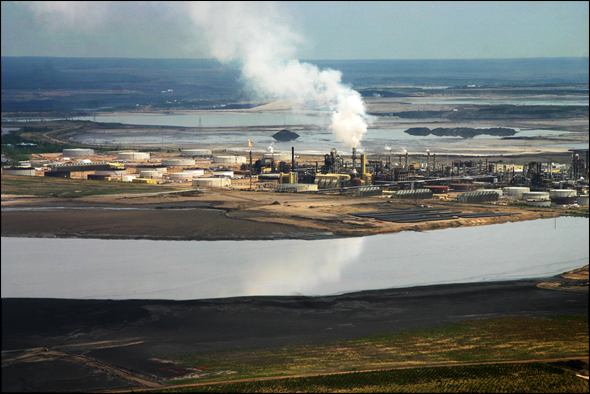
Tar sands oil is contained in solid bitumen—sand grains jacketed by oil that must be mined. Pits are usually striated black and gray. The surrounding boreal forests are green but have diagonal roads scythed into them.

To liberate the oil from the sand, miners blast the bitumen with scalding water, then slurp it off. The leftover slurry of sand, water, and chemicals—“tailings”—fills vast lakes called tailings ponds. The “ponds” cover twice the surface area of Manhattan, and will swell larger through at least 2062. From the air, ponds have different colors, too—rainbow, aqua, wrinkled grey like the skin under a band-aid. In May 2008, 1,600 migrating ducks landed in one pond and drowned.
One old mine worker, Andrew Boucher, a Native American, helped build the first oil mine in the 1960s, then stayed to work for forty years. He piloted a motorboat down the Athabasca River to work in the summer. In the winter he drove a dogsled. He worked until a motor exploded in his face and blinded half his right eye.
On a serpentine trip downriver one freezing August morning, Boucher pointed out his uncles’ old cabins for trapping critters, now mine property. He showed a reporter Tar Island, an earthen dam adjacent to the river that once held back a tailings pond. Tar Island started a dozen yards tall in 1967 but leaked until its owner stanched it with more and more permeable soil. Today it stands ninety yards tall and stretches two miles—and still leaks.
For his job, Boucher sometimes dressed the scarecrows, the bitumen, in hardhats and orange ponchos. His crew also built earthen dikes, and used to find dead birds constantly. “What did you do?” he was asked.
A shrug. Normally they buried them, Jimmy-Hoffa style, in the dike walls.
Ecologists cite statistics about the Pyrrhic scale of tar sand development—the staggering effort needed to eke out oil—to discourage development of tar sands. Tour guides for the mines cite the same facts to delight tourists from Switzerland, Denmark, Germany—to inspire with how powerful modern man is. Some of these Janus facts include: It takes mining 4,400 lbs. of soil to recover about a barrel of crude. One tailings dam is 200 times larger than Hoover Dam. The mobile scoopers that chew back the pits are three-story houses with sideview mirrors as big as bathroom vanities.
Dump trucks reach 50 feet tall and have 10-foot, $70,000 tires and, when full, weigh as much as a Boeing 747. After a shower to shake loose the sticky black dirt, trucks weigh 14 tons less. One perky young guide says executives get their names inscribed on the helmets of bitu-men sometimes, an honor. Her company claims it can regrow original boreal forest on the petcoke waste Hyperion will burn for fuel.
A map of future operations around Ft. McMurray looks like a map of greater Chicago, with colored patches of claims stretching like suburbs for hundreds of miles.
What those eager Korean, Dutch and Japanese companies need are partners to process oil, outlets. No major refineries operate within hundreds of miles.
Crude escapes Ft. McMurray in 24-inch (or larger) pipes, sluicing along at 3 mph, walking speed. It takes 3.5 days to reach Edmonton 270 miles south. Petroleum insiders suspect that when the biggest pipes to America open, a temporary shortage of oil will ensue, because pipes take weeks to fill.
At Other End of Pipe: A Disputed Refinery Still To Take Shape
The American Petroleum Institute recently baptized South Dakota a primary battleground for ensuring access to Canadian tar sands
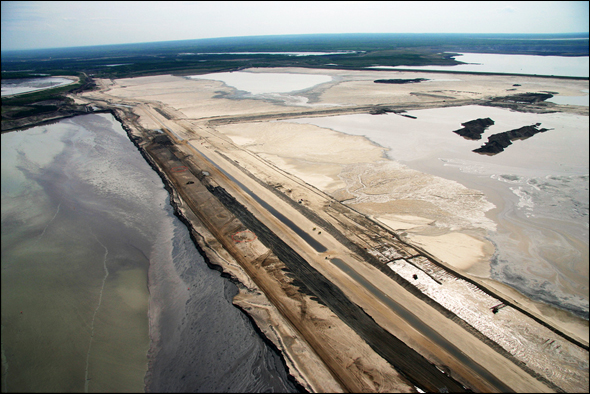
By Sam Kean
Special to Circle of Blue
From Alberta, it will take a 2,000-mile pipeline through farms and wilderness back to Union County, South Dakota and the proposed Hyperion refinery.

Whispers about the new refinery began in earnest in 2006. Finally, after front-page newspaper speculation started, Hyperion Resources, an embattled oil company in Dallas, stepped forward in June 2007 and announced plans to convert 10,000 acres of prairie into the first new domestic oil refinery built since 1976.
Union County sits in the southeast corner of the state near Nebraska and Iowa, bound on either side by the Missouri and the Big Sioux Rivers. The new refinery would snuggle in beside the loess hills nearby, though it’s near impossible to imagine something its size squatting down there, something that would exhale 19 million tons of CO2 each year, more than any existing U.S. refinery, and drink 12 million gallons of water each day.
Its 220-foot smokestacks would stand as some of the tallest structures in this three-story state, almost four times taller than the faces of George and Thomas and Abe and Teddy on Mt. Rushmore. The refinery would lie near the county seat, Elk Point, pop. 1,714, or four miles north to the now-all-but-ghost-town of Spink.
The company published a green charter, promising the refinery would not belch toxic gas at midnight or pour waste out back. It will monitor, and minimize, all sorts of esoteric pollution, such as light and noise pollution. Hyperion will recycle.
“At the end of the day this still is an industrial facility. But we’re taking lower-quality crude and converting it to clean transportation fuels in the most environmentally respons—well, in an environmentally responsible way,” said Preston Phillips, a company executive. “
“And then you talk about water reuse and water recycle strategies.” Phillips added, rising slightly in his chair. “We want to capture all the rainwater on site to supplement the water we need. We’re going to take the gray water from the cafeteria and office building and restrooms for feedwater into the refinery.”
If things go more smoothly than they have for Hyperion, the new refinery will flood the Heartland with 200,000 barrels of gas, 160,000 barrels of diesel, and 40,000 gallons of jet fuel—16.8 million gallons total—every 24 hours.
The plant’s products could add 350 million more pounds of greenhouse gases to Earth’s atmosphere every day, too. Moreover, mining the tar sands to produce the oil to be refined adds an equal amount of greenhouse gases to the atmosphere.
The American Petroleum Institute recently baptized South Dakota a primary battleground for ensuring access to Canadian tar sands. Trans Canada is nearing completion of one pipeline from Alberta through South Dakota to points south and east in the United States, at a cost of $5 billion. A second $7 billion pipeline is in the latter stages of permitting, but last month came under criticism from Henry Waxman, D-Calif., chairman of the House Energy and Commerce Committee, as well as from the Environmental Protection Agency. Both pipelines, when completed, will pump 1.6 million barrels of tar sands oil though the coyote state.
Keith Schneider is senior editor of Circle of Blue. Sam Kean, a Washington D.C.-based writer, is the author of The Disappearing Spoon (Little Brown and Company, 2010). Contact Keith Schneider directly or Kean at samkean@gmail.com.
Graphic by Kalin Wood, a Circle of Blue graphic designer. With contribution from Aubrey Ann Parker, a Circle of Blue reporter and data analyst. Reach them at circleofblue.org/contact.

Circle of Blue’s senior editor and chief correspondent based in Traverse City, Michigan. He has reported on the contest for energy, food, and water in the era of climate change from six continents. Contact
Keith Schneider

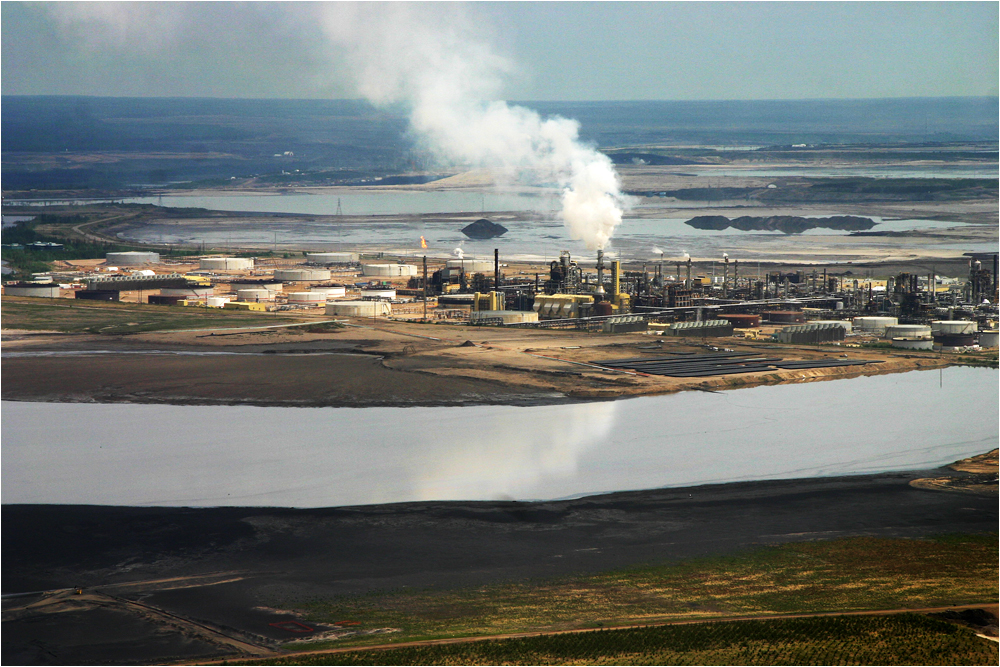

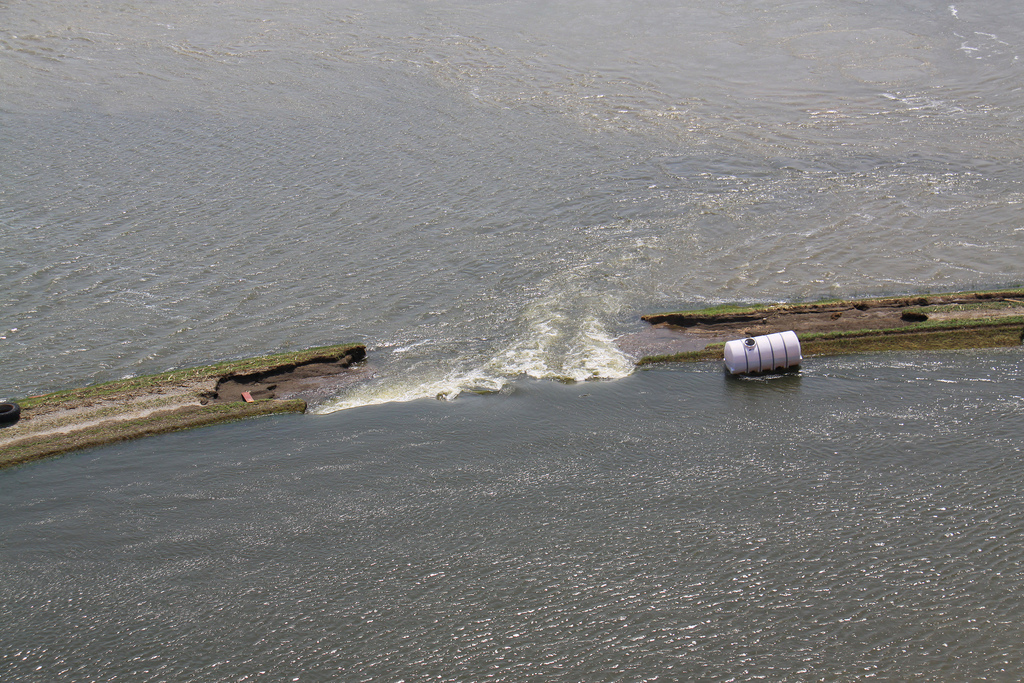
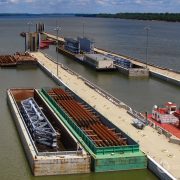
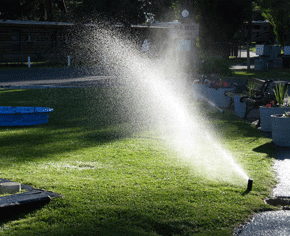



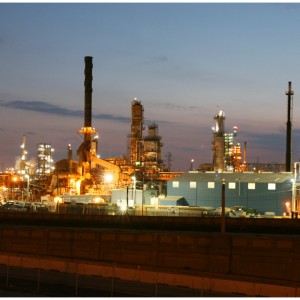
America needs to eliminate its dependency on foreign oil. Although, we make think of Canada as our fifty-first state, it is a sovereign country whose strategic interests do not always align with the US’s.
The problem isn’t dependency on foreign oil, it’s dependency on oil. Every barrel of oil we use has the same effect on the price of oil no matter where the oil comes from, because oil is a commodity traded on a global market. If we suddenly only bought oil from friendly places, hostile groups would benefit from our oil use to the same extent that they do today, and we would be just as vulnerable to price and supply shocks if foreign producers suddenly stopped exporting.
Regardless of that, who would want to look out their kitchen window and see a giant refinery or shale / tar sands mines? None of us. So why would we be OK with putting it in someone else’s back yard? These things aren’t on the back side of the moon where there are no people — they’re near communities just like yours and mine.
The World already has the technology to be independent of oil. The technology was developed and patented decades ago. Electric cars that do not need recharging is the answer. Electric cars can be built today with an unlimited driving range. They don’t need to be hybrids. Not a drop of oil or gas is needed to power an all-electric car. Electric cars have beaten every gas combustion vehicle at the 1/4 mile tracks simply because of the fact that electric motor cars have a higher torque and no hesitation on acceleration.